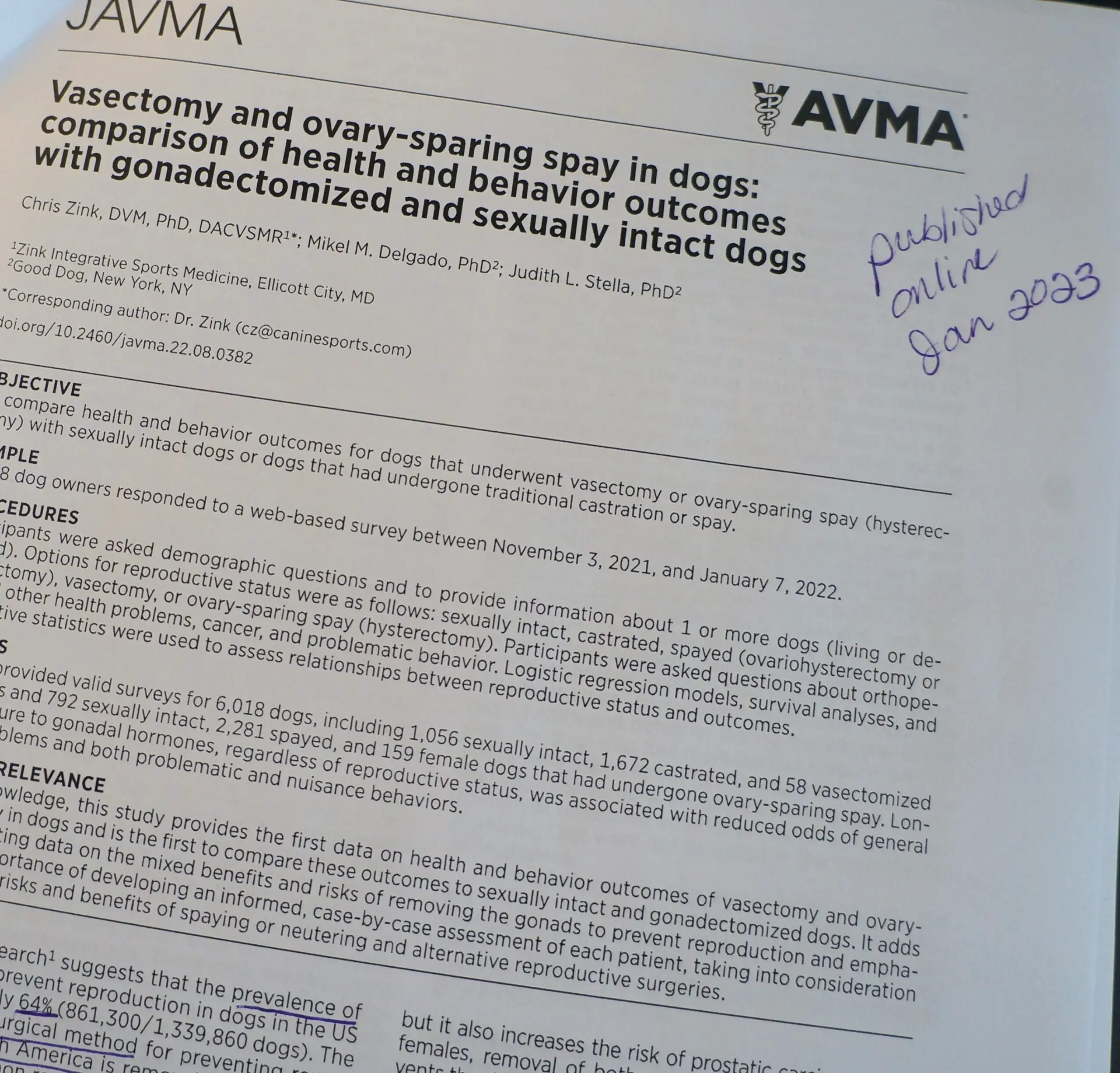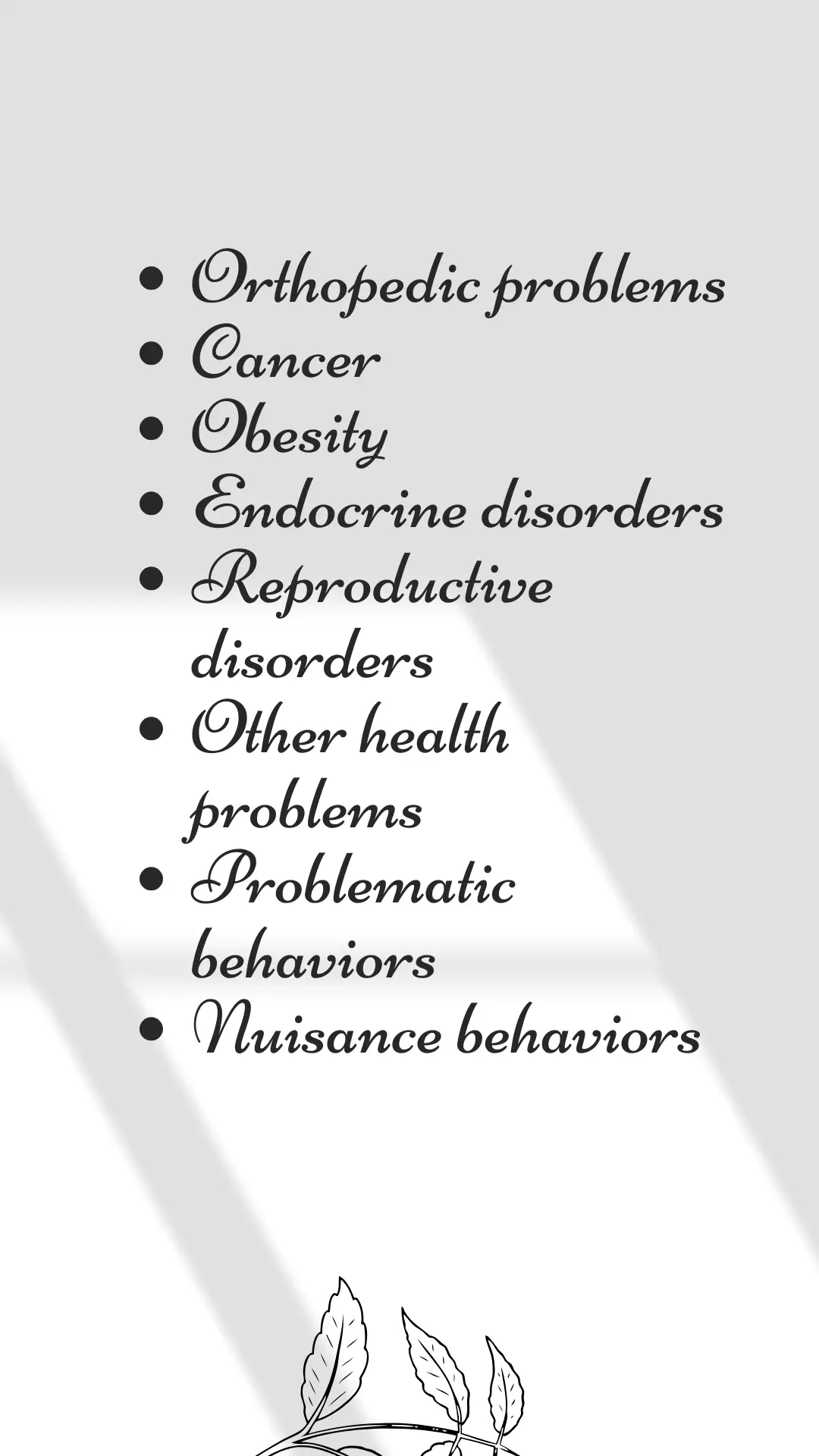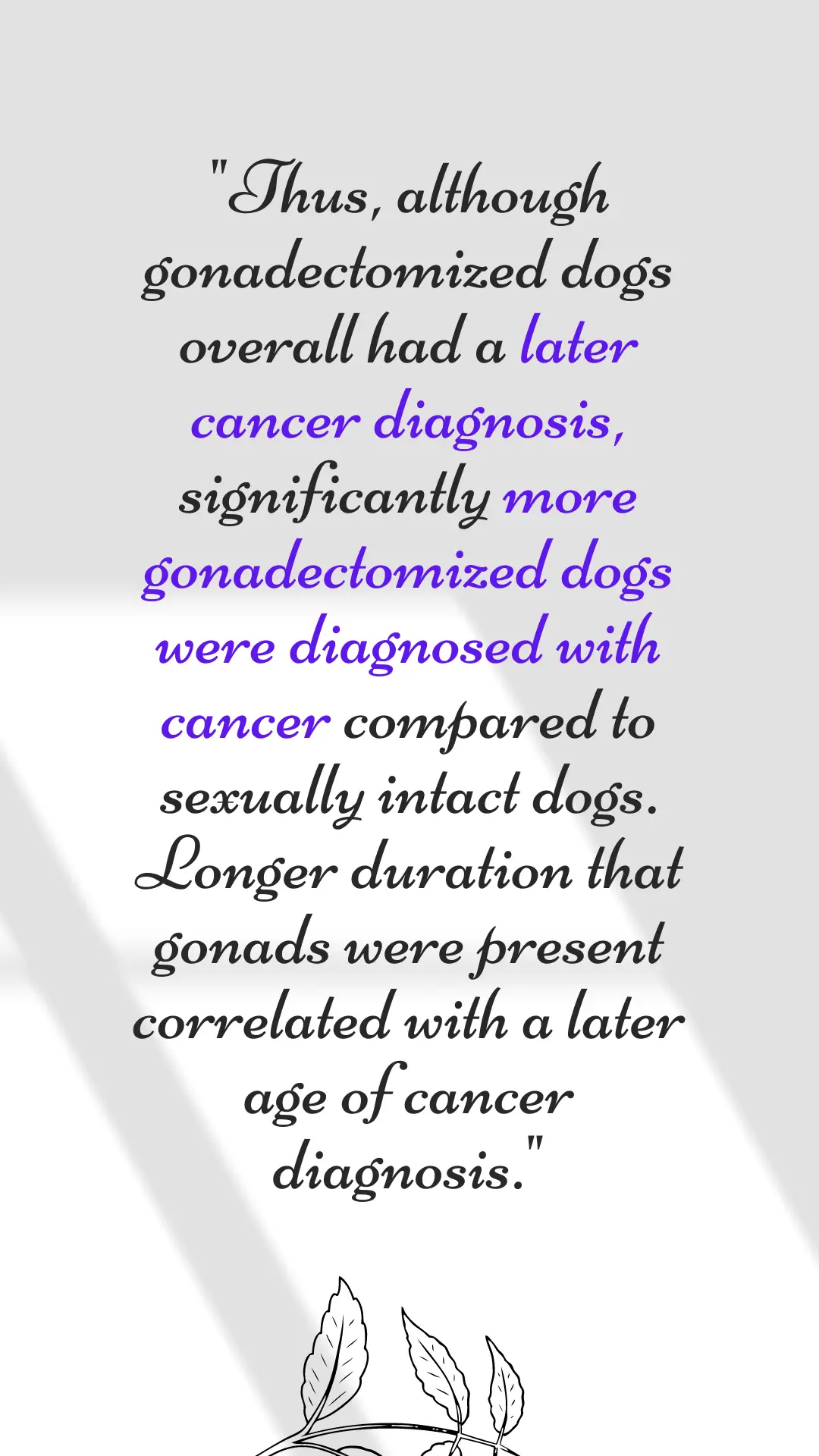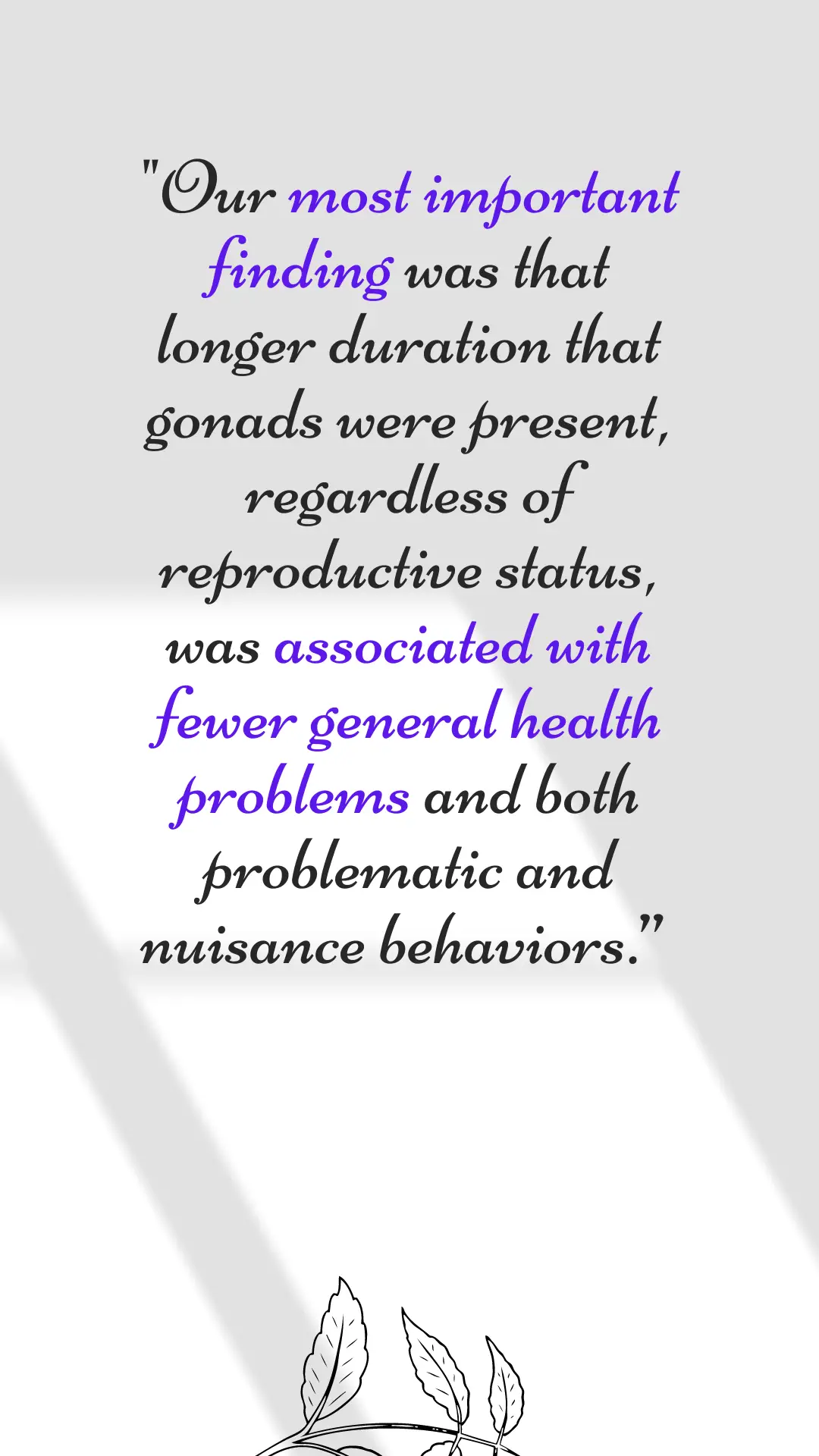Dog Vasectomy and Ovary-Sparing Spay Study

With increasing interest in the benefits of dogs’ longer exposure to gonadal hormones and demand for options other than traditional spay/neuter, a study published in early 2023 caught my attention. It compares health and behavior outcomes for dog vasectomy and ovary-sparing spay patients with both sexually intact dogs and those with gonads surgically removed as is the current standard practice. It’s a small sample for dogs who’ve had those surgeries, but the results look interesting. I tried to include most of the important points.
Here are a few relevant articles on the site:
Overview of Dog Vasectomy and Ovary-Sparing Spay Study
Over 6 weeks in late 2021 and early 2022, researchers collected online surveys from dog people. They deemed a total of 6,018 surveys as complete and valid. Among the dogs represented in the surveys:
- 3,753 were still living
- 2,265 were not
The male dogs in the study broke into these categories:
- 1,065 intact
- 1,672 castrated (traditional neuter surgery)
- 58 dog vasectomy patients
The female dogs in the study broke into these categories:
- 792 intact
- 2,281 spayed (traditional spay surgery)
- 159 ovary-sparing spay patients
Yes, the study’s authors note that the low number of dog vasectomy and ovary sparing spay patients as a major limitation of the research. It’s understandable, though, since it’s a relatively new option and likely not available widely.
The mean age of dogs was 8.85 years, but they ranged from ages 1 to 21.
Health Conditions Compared

They survey and study looked at a bunch of potential health conditions to see if any noticeable and significant differences emerge based on dogs’ reproductive status and procedure used. The full list of health conditions compared in the dog vasectomy and ovary-sparing spay study is long, but researchers grouped them as follows:
- Orthopedic problems, including blown knees
- Cancer
- Obesity
- Endocrine disorders (thyroid disease, diabetes)
- Reproductive disorders
- Other health problems (dental, heart, kidney, and eye diseases and disorders)
- Problematic behaviors (aggression, anxiety)
- Nuisance behaviors (mounting, marking)
Results of Dog Vasectomy and Ovary-Sparing Spay Study
Orthopedic. The orthopedic results found higher risk of problems in both neutered male dogs and spayed female dogs compared to intact male dogs, intact female dogs, and ovary-sparing spay patients. In addition, intact male dogs face a higher risk of orthopedic problems compared to intact female dogs. And, finally, older dogs and those of larger sizes were also associated with increased odds of orthopedic problems.

Cancer. You’ll went to dig into the lengthy section covering the cancer results, but the researchers summarize the findings as follows: “Thus, although gonadectomized dogs overall had a later cancer diagnosis, significantly more gonadectomized dogs were diagnosed with cancer compared to sexually intact dogs. Longer duration that gonads were present correlated with a later age of cancer diagnosis (r = 0.12; P < .001).”
Obesity. While the study did find some differences in obesity, they concluded that “There was no relationship between obesity and duration of gonads present…” even though “Gonadectomized dogs and dogs that underwent ovary-sparing spay were more likely to be obese than sexually intact dogs.”
Endocrine disorders. They did find that intact female dogs were less likely to develop endocrine issues compared to intact male dogs, but “duration of gonads were present … were not related to the presence of an endocrine condition.”
Reproductive conditions. Neutered males were less likely to develop reproductive health issues compared to all other categories. However, the duration of gonads being present and bigger dogs face “increased odds of a reproductive health problem.”
Other health problems. The study found that spayed females were more likely to develop other health issues compared to intact males, intact females, and neutered male dogs. Also, intact male dogs were more likely to have reported health issues compared to intact female dogs. Gonads kept longer lowered the likelihood of other health problems. Again, older and bigger dogs face more health problems.
Problematic behaviors. The associated odds of aggression and anxiety problems decreased with gonads kept longer.
Nuisance behaviors. Intact and spayed females were less likely than intact and neutered males as well as dog vasectomy and ovary sparing spay patients. Maybe no surprise there. However, “longer duration that gonads were present reduced the likelihood of nuisance behaviors.”

Most Important Findings
The published paper includes this statement in the discussion section:
“Our most important finding was that longer duration that gonads were present, regardless of reproductive status, was associated with fewer general health problems and both problematic and nuisance behaviors. It was also associated with an increased lifespan. Because VS and OSS permit dogs to experience longer gonadal hormone exposure times, these data suggest that, when electing surgery to prevent reproduction, dogs might benefit from these alternative surgeries with respect to general health and experience better behavior outcomes compared to undergoing traditional spay-neuter surgery. Delaying traditional spay-neuter surgery could offer similar benefits.”
And, also …
“Taken together, these data suggest that gonadal hormone exposure time may be a more sensitive way to examine the effects of reproductive surgery on health and behavior than categorizing dogs into groups by type of reproductive surgery. This is likely because there may be significant overlap in the length of exposure to gonadal hormones between the 6 groups examined in this study.”
Conclusions of Dog Vasectomy and Ovary-Sparing Spay Study
At the end of the published paper, the authors wrote:
“Nonetheless, these data demonstrated potential health and behavior benefits to dogs of both sexes experiencing longer exposure to gonadal hormones. Given the relatively low risk of these alternative surgeries, particularly in the hands of experienced veterinary practitioners, veterinarians might consider offering these alternative reproductive surgeries to allow dogs to obtain these benefits without experiencing unintentional reproduction.”
